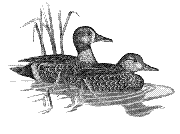US Fish & Wildlife Service
Date of this Version
January 1993
Abstract
The response of wetland vegetation to management can only be interpreted by considering an intricate mix of physiological, ecological, and temporal factors. Because cattail management is important for many freshwater marshes, the purpose of this leaflet is to present autecological principles for such management.
A 50:50 ratio of open water and vegetation is a frequent objective when managing cattail marshes in North America. When a particular marsh has been extensively flooded for some time and few cattails remain, managers may wish to foster more cattails to develop such hemi-marsh conditions. The reverse is followed when a marsh is dominated by cattails. Hemi-marsh conditions are optimal for breeding migratory birds, including most waterfowl, black and Forster’s terns, American coots, and yellow-headed blackbirds. During the nonbreeding season, the life history requirements of migratory birds are not as closely tied to the hemi-marsh conditions. However, such wetlands still provide excellent habitat.
Cattails are prolific and can quickly dominate a wetland plant community. Monotypic stands of cattails have reduced overall habitat value but do benefit some species of wildlife. They provide excellent habitat for wintering white-tailed deer and ring-necked pheasants and habitat for breeding marsh wrens, least bitterns, and various species of blackbirds. However, hemi-marshes also are habitat for these species, too.
Cattails also provide excellent roosting habitat for blackbirds that can severely damage adjacent crops, especially sunflowers in the prairie states. Elimination of the cattail stand removes roosting habitat and can reduce local damage, but the damage is often simply shifted to other areas where the displaced birds create new roosts.
Although the vegetation cycle in prairie marshes is based on the cycle of wet and dry years on the prairies, its basic principles apply to cattail management elsewhere. The cycle of a semipermanent marsh has four stages: dry, regenerating, degenerating, or lake marsh. Identifying the existing stage of a wetland is the first step toward determining the appropriate direction of subsequent management. Generally, all wetlands with cattails in their flora mimic aspects of this prairie marsh cycle. However, certain hydrologic conditions can lengthen the duration of any stage to such an extreme that no cycle is apparent.



Comments
Published in Diana H. Cross and Paul Vohs (eds.) Waterfowl Management Handbook. Fort Collins, CO: U.S. Fish and Wildlife Service, 1988. Online at http://www.nwrc.usgs.gov/wdb/pub/wmh/contents.html